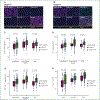Dissecting the clinicopathologic, genomic, and immunophenotypic correlates of KRASG12D-mutated non-small-cell lung cancer
- PMID: 35872166
- PMCID: PMC11006449
- DOI: 10.1016/j.annonc.2022.07.005
Dissecting the clinicopathologic, genomic, and immunophenotypic correlates of KRASG12D-mutated non-small-cell lung cancer
Abstract
Background: Allele-specific KRAS inhibitors are an emerging class of cancer therapies. KRAS-mutant (KRASMUT) non-small-cell lung cancers (NSCLCs) exhibit heterogeneous outcomes, driven by differences in underlying biology shaped by co-mutations. In contrast to KRASG12C NSCLC, KRASG12D NSCLC is associated with low/never-smoking status and is largely uncharacterized.
Patients and methods: Clinicopathologic and genomic information were collected from patients with NSCLCs harboring a KRAS mutation at the Dana-Farber Cancer Institute (DFCI), Memorial Sloan Kettering Cancer Center, MD Anderson Cancer Center, and Imperial College of London. Multiplexed immunofluorescence for CK7, programmed cell death protein 1 (PD-1), programmed death-ligand 1 (PD-L1), Foxp3, and CD8 was carried out on a subset of samples with available tissue at the DFCI. Clinical outcomes to PD-(L)1 inhibition ± chemotherapy were analyzed according to KRAS mutation subtype.
Results: Of 2327 patients with KRAS-mutated (KRASMUT) NSCLC, 15% (n = 354) harbored KRASG12D. Compared to KRASnon-G12D NSCLC, KRASG12D NSCLC had a lower pack-year (py) smoking history (median 22.5 py versus 30.0 py, P < 0.0001) and was enriched in never smokers (22% versus 5%, P < 0.0001). KRASG12D had lower PD-L1 tumor proportion score (TPS) (median 1% versus 5%, P < 0.01) and lower tumor mutation burden (TMB) compared to KRASnon-G12D (median 8.4 versus 9.9 mt/Mb, P < 0.0001). Of the samples which underwent multiplexed immunofluorescence, KRASG12D had lower intratumoral and total CD8+PD1+ T cells (P < 0.05). Among 850 patients with advanced KRASMUT NSCLC who received PD-(L)1-based therapies, KRASG12D was associated with a worse objective response rate (ORR) (15.8% versus 28.4%, P = 0.03), progression-free survival (PFS) [hazard ratio (HR) 1.51, 95% confidence interval (CI) 1.45-2.00, P = 0.003], and overall survival (OS; HR 1.45, 1.05-1.99, P = 0.02) to PD-(L)1 inhibition alone but not to chemo-immunotherapy combinations [ORR 30.6% versus 35.7%, P = 0.51; PFS HR 1.28 (95%CI 0.92-1.77), P = 0.13; OS HR 1.36 (95%CI 0.95-1.96), P = 0.09] compared to KRASnon-G12D.
Conclusions: KRASG12D lung cancers harbor distinct clinical, genomic, and immunologic features compared to other KRAS-mutated lung cancers and worse outcomes to PD-(L)1 blockade. Drug development for KRASG12D lung cancers will have to take these differences into account.
Keywords: G12D; KRAS; NSCLC; PD-(L)1 blockade.
Copyright © 2022 European Society for Medical Oncology. Published by Elsevier Ltd. All rights reserved.
Figures





References
-
- Riely GJ, Ou SHI, Rybin I, et al. 99O_PR KRYSTAL-1: activity and preliminary pharmacodynamic (PD) analysis of adagrasib (MRTX849) in patients (Pts) with advanced non-small cell lung cancer (NSCLC) harboring KRASG12C mutation. J Thorac Oncol. 2021;16:S751–S752.
-
- Wang X, Allen S, Blake JF, et al. Identification of MRTX1133, a non-covalent, potent, and selective KRAS G12D inhibitor. J Med Chem. 2022;65:3123–3133. - PubMed
Publication types
MeSH terms
Substances
Grants and funding
LinkOut - more resources
Full Text Sources
Medical
Research Materials
Miscellaneous

